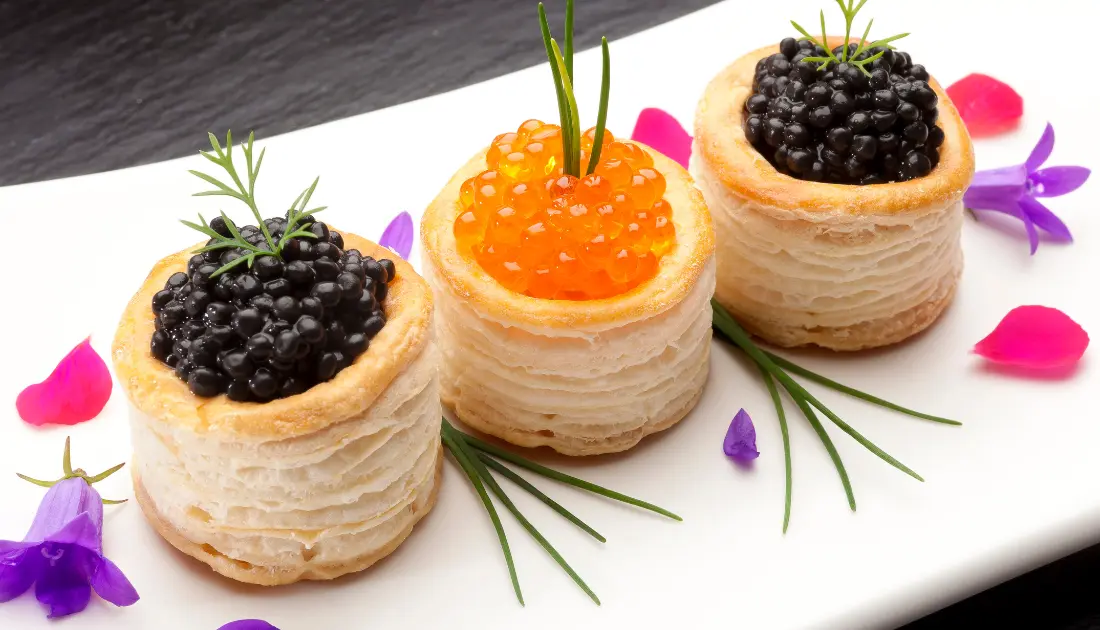Once considered only peasant food, caviar has been harvested since ancient Greek and Roman times. Its rise to popularity even predates favorites like truffles, Champagne, and raw oysters.
While it had been gaining favor with the aristocracy over time, caviar’s popularity sky-rocketed in the late 19th century at the height of Russian Imperialism. The delicacy made its way through high society and went from food for the humble to being reserved only for the aristocracy.
What is the average price of Caviar in Canada?
The price of caviar can vary widely, but on average, you can expect to pay around $60- $95 CAD per 30g (1oz) of caviar. The most expensive caviar on the market is the Almas variety.
This golden caviar is produced by an extremely rare albino beluga sturgeon found in the Caspian Sea that is between 60 and 100 years old and costs $42,474 CAD per kilogram.
Locally produced Canadian caviar can go for $37.26 CAD for a .15 kilogram jar, while Canadian Malossol caviar can be purchased for $8.58 CAD for a 30g (1oz) glass jar.
What affects the Price of Caviar?
Several factors affect the price and quality of caviar. The roe is harvested from one of the 26 different varieties of sturgeon, and some varieties are more expensive than others. Beluga, Osetra, and Sevruga are widely accepted as the best quality.
Higher quality caviar is light in color and comes from older, more mature eggs. Darker caviar is from younger, less mature eggs and will therefore make it less expensive. These darker eggs have a more subtle fishy flavor and can be a good introduction for people just learning to enjoy it.
The move to sustainable caviar and sourcing from more locations around the world has allowed the price of caviar to trend downward. There is a wide variety of caviar on the market today, from the very expensive to more affordable options.
Gone are the days of being limited to local suppliers. With the move to e-commerce, you can source and order caviar online and have it shipped directly to your home. Depending on your location, some companies even offer weekday, overnight delivery.
Some of the other factors that influence the price of caviar include:
1. The availability (or scarcity) of the species of fish.
2. The time it takes for the roe to mature.
3. The grading of the roe – a grading system is used to qualify the egg color, size, flavor, and uniformity. Grade A is better quality and thus more expensive than Grade B.
4. The harvesting and manufacturing process.
5. Popularity.
Caviar vs. Salted Roe
Not all fish roe is edible, and not all roe is equal in taste and quality. This delicacy must be the salted roe, or eggs, from sturgeon to be considered true caviar. Initially, the term was reserved for sturgeon sourced only from the Caspian or Black Sea.
However, due to overfishing, caviar is now sourced from all over the world. The fish you see on your sushi rolls, even in some restaurants, is often salted roe and not true caviar.
A Move to Sustainability
While caviar is still considered a delicacy, it has grown in availability in recent years. For example, Beluga caviar became illegal in the U.S. in 2005 after it was almost fished to the brink of extinction.
With the love of caviar not decreasing despite limited resources, people began to seek out more sustainable sources. Justin Henry of Sechelt, British Columbia, saw an opportunity and in 2000 began raising sturgeon in his hatchery.
While the fish spawn within eight years, he waited an impressive thirteen years before launching his Target Maine, sustainable and organic caviar. The brand was wildly successful, producing 400 kilograms of caviar in 2014. That is just one example of Canadian companies leading the charge to offer better, more sustainable options.
Bottom Line
Caviar is a delicacy. Due to the time it takes for sturgeon roe to mature, be sourced, and produced, even lower quality black caviar is still more expensive than many people can afford.
Although well worth the price for the luxury, there are other alternatives for someone who wants the same experience without the hefty price tag. Different species of fish roe can offer an affordable option that, while it may not carry the same social provenance as true caviar, can provide an equally enjoyable experience.
For the price of an entree at a local restaurant, the inclusion of caviar and similar salted roes in many popular dishes allows Canadians to splurge a little without breaking the bank.








